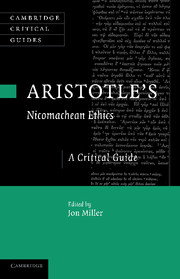Book contents
- Frontmatter
- Contents
- Contributors
- Acknowledgments
- Abbreviations and transliteration
- Introduction
- Part I Textual issues
- Part II Happiness
- Part III Philosophical psychology
- Chapter 5 Aristotle???s definition of non-rational pleasure and pain and desire
- Chapter 6 Non-rational desire and Aristotle???s moral psychology
- Chapter 7 Aristotle, agents, and actions
- Chapter 8 Perfecting pleasures
- Chapter 9 Inappropriate passion
- Part IV Virtues
- Bibliography
- Index
Chapter 5 - Aristotle???s definition of non-rational pleasure and pain and desire
Published online by Cambridge University Press: 07 September 2011
- Frontmatter
- Contents
- Contributors
- Acknowledgments
- Abbreviations and transliteration
- Introduction
- Part I Textual issues
- Part II Happiness
- Part III Philosophical psychology
- Chapter 5 Aristotle???s definition of non-rational pleasure and pain and desire
- Chapter 6 Non-rational desire and Aristotle???s moral psychology
- Chapter 7 Aristotle, agents, and actions
- Chapter 8 Perfecting pleasures
- Chapter 9 Inappropriate passion
- Part IV Virtues
- Bibliography
- Index
Summary
“And what is natural is pleasant; and all pursue their natural pleasure.”
(Aristotle, Historia Animaliumix.1, 589a8–9, trans. D. M. Balme)Aristotle thinks that it is not enough for us to simply know what virtue is, but that we also need to know how to bring virtue about. In order to do this, it is vital to have some insight into the non-rational mechanisms of human behavior, since, for Aristotle, the acquisition of virtue does not primarily consist in intellectual instruction, but in an adequate conditioning of our non-rational motivational dispositions. Before engaging in ethical debates, therefore, the young ought to be habituated in the right way such that they non-rationally desire and feel pleasure and pain about the right things. Non-rational pleasure and pain and desire thus provide a psychological mechanism which is central for the practical purpose of Aristotle’s ethical project. But what is this mechanism? This is the question I am going to investigate in this chapter. For Aristotle, such an investigation, since it is not concerned with rational behavior, falls into the domain of his natural philosophy. And it is from this perspective that I will approach the question here, too, namely from the perspective of Aristotle’s theory of animal behavior in his De Anima.
- Type
- Chapter
- Information
- Aristotle's Nicomachean EthicsA Critical Guide, pp. 117 - 143Publisher: Cambridge University PressPrint publication year: 2011
- 9
- Cited by



